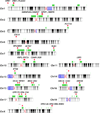Copy-number variation is an important contributor to the genetic causality of inherited retinal degenerations
- PMID: 27735924
- PMCID: PMC6377944
- DOI: 10.1038/gim.2016.158
Copy-number variation is an important contributor to the genetic causality of inherited retinal degenerations
Abstract
Purpose: Despite substantial progress in sequencing, current strategies can genetically solve only approximately 55-60% of inherited retinal degeneration (IRD) cases. This can be partially attributed to elusive mutations in the known IRD genes, which are not easily identified by the targeted next-generation sequencing (NGS) or Sanger sequencing approaches. We hypothesized that copy-number variations (CNVs) are a major contributor to the elusive genetic causality of IRDs.
Methods: Twenty-eight cases previously unsolved with a targeted NGS were investigated with whole-genome single-nucleotide polymorphism (SNP) and comparative genomic hybridization (CGH) arrays.
Results: Deletions in the IRD genes were detected in 5 of 28 families, including a de novo deletion. We suggest that the de novo deletion occurred through nonallelic homologous recombination (NAHR) and we constructed a genomic map of NAHR-prone regions with overlapping IRD genes. In this article, we also report an unusual case of recessive retinitis pigmentosa due to compound heterozygous mutations in SNRNP200, a gene that is typically associated with the dominant form of this disease.
Conclusions: CNV mapping substantially increased the genetic diagnostic rate of IRDs, detecting genetic causality in 18% of previously unsolved cases. Extending the search to other structural variations will probably demonstrate an even higher contribution to genetic causality of IRDs.Genet Med advance online publication 13 October 2016.
Conflict of interest statement
The authors declare no conflict of interest related to the work presented in this manuscript.
Figures




References
-
- Berger W, Kloeckener-Gruissem B, Neidhardt J. The molecular basis of human retinal and vitreoretinal diseases. Prog Retin Eye Res. 2010;29(5):335–375. - PubMed
-
- Hartong DT, Berson EL, Dryja TP. Retinitis pigmentosa. Lancet. 2006;368(9549):1795–1809. - PubMed
-
- [Accessed May 2016];Retinal Information Network (RetNet) available at https://sph.uth.edu/retnet/home.htm.
Publication types
MeSH terms
Grants and funding
LinkOut - more resources
Full Text Sources
Other Literature Sources

